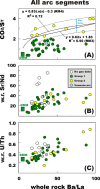CO2 flux emissions from the Earth's most actively degassing volcanoes, 2005-2015
- PMID: 30931997
- PMCID: PMC6443792
- DOI: 10.1038/s41598-019-41901-y
CO2 flux emissions from the Earth's most actively degassing volcanoes, 2005-2015
Abstract
The global carbon dioxide (CO2) flux from subaerial volcanoes remains poorly quantified, limiting our understanding of the deep carbon cycle during geologic time and in modern Earth. Past attempts to extrapolate the global volcanic CO2 flux have been biased by observations being available for a relatively small number of accessible volcanoes. Here, we propose that the strong, but yet unmeasured, CO2 emissions from several remote degassing volcanoes worldwide can be predicted using regional/global relationships between the CO2/ST ratio of volcanic gases and whole-rock trace element compositions (e.g., Ba/La). From these globally linked gas/rock compositions, we predict the CO2/ST gas ratio of 34 top-degassing remote volcanoes with no available gas measurements. By scaling to volcanic SO2 fluxes from a global catalogue, we estimate a cumulative "unmeasured" CO2 output of 11.4 ± 1.1 Mt/yr (or 0.26 ± 0.02·1012 mol/yr). In combination with the measured CO2 output of 27.4 ± 3.6 Mt/yr (or 0.62 ± 0.08·1012 mol/yr), our results constrain the time-averaged (2005-2015) cumulative CO2 flux from the Earth's 91 most actively degassing subaerial volcanoes at 38.7 ± 2.9 Mt/yr (or 0.88 ± 0.06·1012 mol/yr).
Conflict of interest statement
The authors declare no competing interests.
Figures






References
-
- Dasgupta R, Hirschmann MM. The deep carbon cycle and melting in Earth’s interior. Earth Planet. Sci. Lett. 2010;298:1–13. doi: 10.1016/j.epsl.2010.06.039. - DOI
-
- Berner, R. A. The Phanerozoic Carbon Cycle: CO2 and O2. Oxford University Press (2004).
-
- Lee C-T, et al. Continental arc–island arc fluctuations, growth of crustal carbonates, and long-term climate change. Geosphere. 2013;9:21–36. doi: 10.1130/GES00822.1. - DOI
-
- Royer DL, Donnadieu Y, Park J, Kowalczyk J, Goddéris Y. Error analysis of CO2 and O2 estimates from the long-term geochemical model GEOCARBSULF. Am. J. Sci. 2014;314:1259–1283. doi: 10.2475/09.2014.01. - DOI
LinkOut - more resources
Full Text Sources
Miscellaneous

